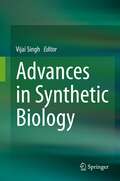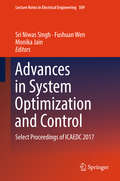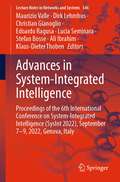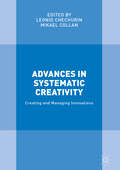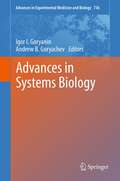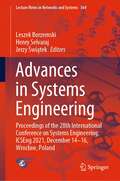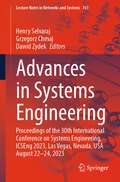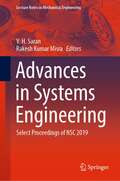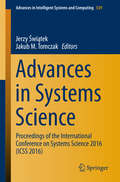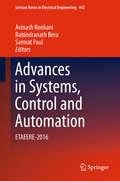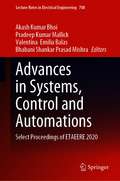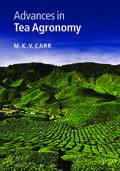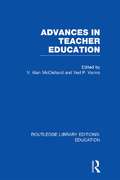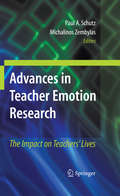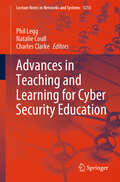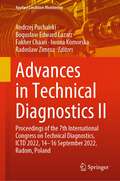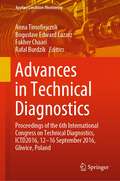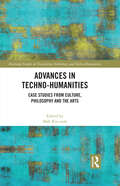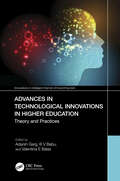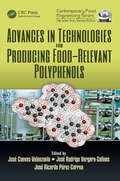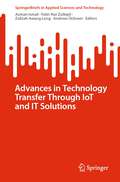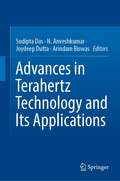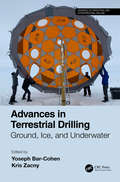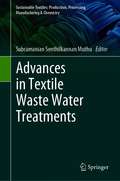- Table View
- List View
Advances in Synthetic Biology
by Vijai SinghThis book addresses the design of emerging conceptual tools, technologies and systems including novel synthetic parts, devices, circuits, oscillators, biological gates, and small regulatory RNAs (riboregulators and riboswitches), which serve as versatile control elements for regulating gene expression. Synthetic biology, a rapidly growing field that involves the application of engineering principles in biology, is now being used to develop novel systems for a wide range of applications including diagnostics, cell reprogramming, therapeutics, enzymes, vaccines, biomaterials, biofuels, fine chemicals and many more. The book subsequently summarizes recent developments in technologies for assembling synthetic genomes, minimal genomes, synthetic biology toolboxes, CRISPR-Cas systems, cell-free protein synthesis systems and microfluidics. Accordingly, it offers a valuable resource not only for beginners in synthetic biology, but also for researchers, students, scientists, clinicians, stakeholders and policymakers interested in the potential held by synthetic biology.
Advances in System Optimization and Control: Select Proceedings of ICAEDC 2017 (Lecture Notes in Electrical Engineering #509)
by Sri Niwas Singh Fushuan Wen Monika JainThis book comprises select proceedings of the International Conference on Advancement in Energy, Drives, and Control. It covers frontier topics in optimization and control. It covers applications of optimization processes in areas such as computer architecture, communication systems, system optimization, signal processing, fluid dynamics and process control. This book is of use to researchers, professionals, and students from across engineering disciplines.
Advances in System-Integrated Intelligence: Proceedings of the 6th International Conference on System-Integrated Intelligence (SysInt 2022), September 7-9, 2022, Genova, Italy (Lecture Notes in Networks and Systems #546)
by Dirk Lehmhus Maurizio Valle Klaus-Dieter Thoben Stefan Bosse Ali Ibrahim Christian Gianoglio Edoardo Ragusa Lucia SeminaraThis book reports on cutting-edge research and developments focusing on integrating intelligent functionalities into materials, components, systems and products. Gathering the proceedings of the 6th International Conference on System-Integrated Intelligence (SysInt 2022), held on September 7-9, in Genova, Italy, it offers a comprehensive, multidisciplinary and applied perspective on the state-of-the art and challenges in the field of intelligent, flexible and connected systems. The book covers advanced methods and applications relating to artificial, pervasive and ubiquitous intelligence, sensors, smart factory and logistics, structural health monitoring, as well as soft robotics, cognitive systems and human-machine interaction. Giving a special focus to artificial intelligence, it extensively reports on methods and algorithms for data-driven modeling, and agent-based data processing and planning. It aims at inspiring and fostering collaboration between researchers and professionals from the different fields of electrical, manufacturing and production engineering, and materials and computer sciences.
Advances in Systematic Creativity: Creating and Managing Innovations
by Mikael Collan Leonid ChechurinThis book presents a collection of the most current research into systemic creativity and TRIZ, engendering discussion and the exchange of new discoveries in the field. With chapters on idea generation, decision making, creativity support tools, artificial intelligence and literature based discovery, it will include a number of instruments of inventive design automation. Consisting of 15-20 chapters written by leading experts in the theory for inventive problem solving (TRIZ) and adjacent fields focused upon heuristics, the contributions will add to the method of inventive design, dialogue with other tools and methods, and teaching creativity in management education through real-life case studies.
Advances in Systems Biology (Advances in Experimental Medicine and Biology #736)
by Igor I. Goryanin Andrew B. GoryachevThe International Society for Systems Biology (ISSB) is a society aimed at advancing world-wide systems biology research by providing a forum for scientific discussions and various academic services. The ISSB helps coordinate researchers to form alliances for meeting the unique needs of multidisciplinary and international systems biology research. The annual International Conference on Systems Biology (ICSB) serves as the main meeting for the society and is one of the largest academic and commercial gatherings under the broad heading of 'Systems Biology'.
Advances in Systems Engineering: Proceedings of the 28th International Conference on Systems Engineering, ICSEng 2021, December 14-16, Wrocław, Poland (Lecture Notes in Networks and Systems #364)
by Jerzy Świątek Leszek Borzemski Henry SelvarajThis book features high-quality, peer-reviewed papers from the 28th International Conference Systems Engineering (ICSEng 2021), held at Wrcław University of Science and Technology, Wrocław, Poland, on December 14–16, 2021. Presenting the latest developments and technical solutions in systems engineering, it covers a variety of topics, such as analog and digital hardware systems, artificial intelligence and machine learning, distance learning & games, E-business systems, financial technology, general control systems, hyper-automation and Industry 4.0, Internet of things, sensor and biometric systems, medical systems and applications, robotics, computer vision, HCI, and parallel and distributed systems. As such, it helps those in the computer industry and academia to use the advances in next-generation systems engineering technology to shape real-world applications.
Advances in Systems Engineering: Proceedings of the 30th International Conference on Systems Engineering, ICSEng 2023, Las Vegas, Nevada, USA August 22-24, 2023 (Lecture Notes in Networks and Systems #761)
by Henry Selvaraj Dawid Zydek Grzegorz ChmajThis book presents the proceedings of the 30th International Conference on Systems Engineering held at the University of Nevada, Las Vegas (UNLV), USA, during August 22-24, 2023. Research in the discipline of Systems Engineering is an important concept in the advancement of engineering and information sciences. Systems Engineering attempts to integrate many of the traditional engineering disciplines to solve large complex functioning engineering systems, dependent on components from all the disciplines. The research papers contained in these proceedings reflect the state of the art in systems engineering from all over the world and should serve as vital references to researchers to follow. The topics covered in this book include AeroSpace Systems, Cyber-Physical Systems, Autonomous Systems, Sensor Networks, Machine Learning and Analytics, Internet of Things, Applied Media Informatics and Technology, Control Systems, Energy Systems, Automotive Systems, Biological Systems, Vehicular Networking and Connected Vehicles, Aerospace Systems, Automation, Manufacturing, Smart Grids, Nonlinear Systems, Power Systems, Robotics, Social Systems, Economic Systems, and others. This book is a very good resource for graduate students, researchers, and scholars who want to learn about the most recent development in the fields.
Advances in Systems Engineering: Select Proceedings of NSC 2019 (Lecture Notes in Mechanical Engineering)
by V. H. Saran Rakesh Kumar MisraThis book comprises select proceedings of the 43rd National Systems Conference on Innovative and Emerging Trends in Engineering Systems (NSC 2019) held at the Indian Institute of Technology, Roorkee, India. The contents cover latest research in the highly multidisciplinary field of systems engineering, and discusses its various aspects like systems design, dynamics, analysis, modeling and simulation. Some of the topics covered include computing systems, consciousness systems, electrical systems, energy systems, manufacturing systems, mechanical systems, literary systems, social systems, and quantum and nano systems. Given the scope of the contents, this book will be useful for researchers and professionals from diverse engineering and management background.
Advances in Systems Science: Proceedings of the International Conference on Systems Science 2016 (ICSS 2016) (Advances in Intelligent Systems and Computing #539)
by Jerzy Świątek Jakub M. TomczakThis book gathers the carefully reviewed proceedings of the 19th International Conference on Systems Science, presenting recent research findings in the areas of Artificial Intelligence, Machine Learning, Communication/Networking and Information Technology, Control Theory, Decision Support, Image Processing and Computer Vision, Optimization Techniques, Pattern Recognition, Robotics, Service Science, Web-based Services, Uncertain Systems and Transportation Systems. The International Conference on Systems Science was held in Wroclaw, Poland from September 7 to 9, 2016, and addressed a range of topics, including systems theory, control theory, machine learning, artificial intelligence, signal processing, communication and information technologies, transportation systems, multi-robotic systems and uncertain systems, as well as their applications. The aim of the conference is to provide a platform for communication between young and established researchers and practitioners, fostering future joint research in systems science.
Advances in Systems, Control and Automation: ETAEERE-2016 (Lecture Notes in Electrical Engineering #442)
by Avinash Konkani Rabindranath Bera Samrat PaulThis book comprises the select proceedings of the ETAEERE 2016 conference. The book aims to shed light on different systems or machines along with their complex operation, behaviors, and linear-nonlinear relationship in different environments. It covers problems of multivariable control systems and provides the necessary background for performing research in the field of control and automation. Aimed at helping readers understand the classical and modern design of different intelligent automated systems, the book presents coverage on the control of linear and nonlinear systems, intelligent systems, stochastic control, knowledge-based systems applications, fault diagnosis and tolerant control, real-time control applications, etc. The contents of this volume will prove useful to researchers and professionals alike.
Advances in Systems, Control and Automations: Select Proceedings of ETAEERE 2020 (Lecture Notes in Electrical Engineering #708)
by Bhabani Shankar Prasad Mishra Valentina Emilia Balas Akash Kumar Bhoi Pradeep Kumar MallickThis book comprises select proceedings of the international conference ETAEERE 2020. This volume covers latest research in advanced approaches in automation, control based devices, and adaptive learning mechanisms. The contents discuss the complex operations and behaviors of different systems or machines in different environments. Some of the areas covered include control of linear and nonlinear systems, intelligent systems, stochastic control, knowledge-based systems applications, fault diagnosis and tolerant control, and real-time control applications. The contents of this volume can be useful for researchers as well as professionals working in control and automation.
Advances in TNF Family Research: Proceedings of the 12th International TNF Conference, 2009 (Advances in Experimental Medicine and Biology #691)
by Andrew Kovalenko David Wallach Marc FeldmannThe biennial TNF-family conferences have been held over the past 20 years, from the time that TNF was cloned. These meetings have followed the enormous progress in this field. Much is now known about the members of the TNF ligand and receptor families, their signaling proteins, mechanisms of action and cellular functions. This volume is the proceedings of the 12th TNF International Conference, held in April 2009. This conference focuses on the physiological, pathophysiological, and medical significance of these important regulators. Sessions at the meeting specifically address their involvement in immunity, development, apoptosis, autoimmunity, cancer, and infection, the normal function and pathology of the neuronal system, as well as major unresolved questions about their mechanisms of action.
Advances in Tea Agronomy
by M. Carr M. K. V. Congdon T. C. E. Corley R. H. V. G. K. Tuwei C. J. Flowers M. Upson Perez OrtolaTea is big business. After water, tea is believed to be the most widely consumed beverage in the world. And yet, as productivity increases, the real price of tea declines while labour costs continue to rise. Tea remains a labour intensive industry. With a distinguished career spanning over 50 years and rich experience in diverse crops, Mike Carr is eminently qualified to indulge in an intelligent discourse on tea agronomy. In addition to a comprehensive review of the principal tea growing regions worldwide in terms of structure, productivity and principal constraints, he has attempted to question and seeks to find the associated experimental evidence needed to support current and future crop management practices. The book will assist all those involved in the tea industry to become creative thinkers and to question accepted practices. International in content, it will appeal to practitioners and students from tea growing countries worldwide.
Advances in Teacher Education (Routledge Library Editions: Education)
by Ved P. Varma V. Alan McclellandDuring the 1980s, Britain’s educational system was restructured and redirected. Of the many changes which were made, perhaps the most far-reaching have affected the education of teachers themselves.The contributors to this book have all been centrally involved in the reforming process of teacher education, as providers, assessors, or practitioners, and it is as such that they reflect upon the significant features of the changes in teacher education, while assessing the fulfilment of the initial promise. The book analyses recent advances in teacher education, especially the trend towards improved teacher awareness and explains the application of new ideas in education, considering their political causes and effects. The first critical appraisal of the Thatcherite reform of teacher education, this book also provides an up-to-date examination of the support services for teachers in-service, and shows what is amiss with the government’s strategies for in-service training.With its clear insights into the pressing concerns of teacher education today, Advances in Teacher Education will be an invaluable resource base for students, teachers, lectures, and educational administrators as they attempt to understand the motivation and stresses of teacher reform.
Advances in Teacher Emotion Research: The Impact on Teachers' Lives
by Michalinos Zembylas Paul A. SchutzSome reports estimate that nearly 50% of teachers entering the profession leave within the first five years (Alliance for Excellent Education 2004; Ingersoll, 2003; Quality Counts 2000). One explanation of why teachers leave the profession so early in their career might be related to the emotional nature of the teaching profession. For example, teaching is an occupation that involves considerable emotional labor. Emotional labor involves the effort, planning, and control teachers need to express organizationally desired emotions during interpersonal transactions. As such, emotional labor has been associated with job dissatisfaction, health symptoms and emotional exhaustion, which are key components of burnout and related to teachers who drop out of the profession. Research into emotional labor in teaching and other aspects of teachers' emotions is becoming increasingly important not only because of the growing number of teachers leaving the profession, but also because unpleasant classroom emotions have considerable implications for student learning, school climate and the quality of education in general. Using a variety of different methodological and theoretical approaches, the authors in this edited volume, Advances in Teacher Emotion Research: The Impact on Teachers' Lives, provide a systematic overview that enriches our understanding of the role of emotions in teachers' professional lives and work. More specifically, the authors discuss inquiry related to teachers' emotions in educational reform, teacher identity, student involvement, race/class/gender issues, school administration and inspection, emotional labor, teacher burnout and several other related issues. This volume, then, represents the accumulation of different epistemological and theoretical positions related to inquiry on teachers' emotions, acknowledging that emotions are core components of teachers' lives. Advances in Teacher Emotion Research takes an eclectic look at teacher emotions, presenting current research from diverse perspectives, thereby making this volume a significant contribution to the field.
Advances in Teaching and Learning for Cyber Security Education (Lecture Notes in Networks and Systems #1213)
by Charles Clarke Phil Legg Natalie CoullThis book showcases latest trends and innovations for how we teach and approach cyber security education. Cyber security underpins the technological advances of the 21st century and is a fundamental requirement in today’s society. Therefore, how we teach and educate on topics of cyber security and how we overcome challenges in this space require a collective effort between academia, industry and government. The variety of works in this book include AI and LLMs for cyber security, digital forensics and how teaching cases can be generated at scale, events and initiatives to inspire the younger generations to pursue cyber pathways, assessment methods that provoke and develop adversarial cyber security mindsets and innovative approaches for teaching cyber management concepts. As a rapidly growing area of education, there are many fascinating examples of innovative teaching and assessment taking place; however, as a community we can do more to share best practice and enhance collaboration across the education sector. CSE Connect is a community group that aims to promote sharing and collaboration in cyber security education so that we can upskill and innovate the community together. The chapters of this book were presented at the 4th Annual Advances in Teaching and Learning for Cyber Security Education conference, hosted by CSE Connect at the University of the West of England, Bristol, the UK, on July 2, 2024. The book is of interest to educators, students and practitioners in cyber security, both for those looking to upskill in cyber security education, as well as those aspiring to work within the cyber security sector.
Advances in Technical Diagnostics II: Proceedings of the 7th International Congress on Technical Diagnostics, ICTD 2022, 14–16 September 2022, Radom, Poland (Applied Condition Monitoring #21)
by Fakher Chaari Radoslaw Zimroz Bogusław Edward Łazarz Andrzej Puchalski Iwona KomorskaThis book reports on recent theories and methods for diagnostics and condition monitoring of machines, materials and industrial processes, with a special emphasis on the application of artificial intelligence and intelligent control systems. Gathering original contributions to the 7th International Congress on Technical Diagnostics, ICTD2022, held on September 14–16, 2022, in Radom, Poland, this book offers extensive information on the latest trends in machine diagnostics and on IoT, smart sensors and machine learning technology in advanced condition monitoring. It addresses both scientists and professionals and is intended to foster communication and collaborations between the two groups.
Advances in Technical Diagnostics: Proceedings of the 6th International Congress on Technical Diagnostic, ICDT2016, 12 - 16 September 2016, Gliwice, Poland (Applied Condition Monitoring #10)
by Fakher Chaari Anna Timofiejczuk Bogusław Edward Łazarz Rafał BurdzikThis book provides readers with an overview of recent theories and methods for machinery diagnostics applied to machinery maintenance. Each chapter, accepted after a rigorous peer-review process, reports on a selected, original piece of work discussed at the International Congress on Technical Diagnostic, ICDT2016, held on September 12 - 16, 2016, in Gliwice, Poland. The book covers a broad range of topics, including machines operating in non-stationary conditions, and examples from different industrial fields of mechanical, civil, computer and electronic engineering as well as the medical, food, automotive, and mining industries. By presenting state-of-the-art diagnostic solutions and discussing important industrial issues the book offers a valuable resource to both academics and professionals as well as a bridge to facilitate communication and collaboration between the two groups.
Advances in Techno-Humanities: Case Studies from Culture, Philosophy and the Arts (Routledge Studies in Translation Technology and Techno-Humanities)
by Mak Kin-WahThis book is a pioneering attempt to explore the relationships between technology and the humanities through case studies and specific contexts in the areas of language, theatre, literature, translation, philosophy, music, home designations, learning environment, and artificial intelligence. Written by scholars and specialists across various fields, the chapters explore the emerging field of techno-humanities. This book examines the development of language and society by means of Big Data, how technology is integrated into the theatres of Hong Kong and the ensuing results of such integration. The authors also highlight how technology is able to analyse, understand, and visualise literary works and to bring drastic changes to translation in the past seven decades. Long-standing philosophical issues are re-examined, linkages between technology and theoretical concepts are illuminated, and the emotional aspects of computational applications are investigated. This book also delves into insightful case studies such as providing suggestions to train novice translators through corpus-assisted translation teaching, analysing patterns of housing names, and discovering a new online method to acknowledge acquisition through authentic learning experiences. Overall, this book serves as a point of departure for us to go deeper into the role of technology in transforming the humanities in this digital age. This is a useful read for students and scholars interested in learning more about the cross section between humanities and technology.
Advances in Technological Innovations in Higher Education: Theory and Practices (Innovations in Intelligent Internet of Everything (IoE))
by Adarsh Garg Valentina E Balas B V BabuThe evolution of technology in education can no longer be comprehended simply by looking at the use of computers and networks. Technology is not just a supplementary tool to the conventional method of education. Education has to undergo a complete transformation with technological innovations for the sustainability of quality education as a system and not in silos. Sustainability in education also necessitates a more workable strategy to realize socially viable educational policies and practices which can focus more on personalized learning. Due to various factors like emerging technologies; changing needs of the learners; policy reforms for enhancing employability; and emphasis on uninterrupted education as in the case of the pandemic scenario of COVID-19, there is a need to steer a major transition in the education system. The education system has to be real and proficient for it to be instrumental to nurture an informed and knowledgeable society. This book on technological innovations in higher education is organized, largely, based on the diversity of higher education ecosystems that are supported by technological innovations. Various author viewpoints give insights into the full potential of technology as well as its risks in interrelated areas of higher education to work towards sustainability of value-based quality education across the globe.
Advances in Technologies for Producing Food-relevant Polyphenols (Contemporary Food Engineering)
by José Cuevas-Valenzuela, José Rodrigo Vergara-Salinas and José Ricardo Pérez-CorreaThe growing concern for human wellbeing has generated an increase in the demand for polyphenols, secondary plant metabolites that exhibit different bioactive properties. This increasing demand is mainly due to the current applications in the food industry where polyphenols are considered essential for human health and nutrition. Advances in Technologies for Producing Food-relevant Polyphenols provides researchers, scientists, engineers, and professionals involved in the food industry with the latest methodologies and equipment useful to extract, isolate, purify, and analyze polyphenols from different available sources, such as herbs, flora, vegetables, fruits, and agro-industrial wastes. Technologies currently used to add polyphenols to diverse food matrices are also included. This book serves a reference to design and scale-up processes to obtain polyphenols from different plant sources and to produce polyphenol-rich foods with bioactive properties (e.g. antioxidant, antibacterial, antiviral, anticancer properties) of interest for human health and wellbeing.
Advances in Technology Transfer Through IoT and IT Solutions (SpringerBriefs in Applied Sciences and Technology)
by Andreas Öchsner Azman Ismail Fatin Nur Zulkipli Zalizah Awang LongThis book describes common applied problems that are solved with the use of digital technology. The digital technology has simplified most of our daily activities. Technology has been improving our quality of life where human capability alone is insufficient enough to be utilized. For any challenging tasks, digital technology helps to solve it in very efficient ways and thousands of them are solved on a daily basis without much notice in the public. Software and IT technology let us to complete tasks in just a moment that took days without this technical support. In that sense, this book presents several examples on how software- and IT-based solutions were successfully applied in solving actual engineering problems.
Advances in Terahertz Technology and Its Applications
by Joydeep Dutta Arindam Biswas Sudipta Das N. AnveshkumarThis book highlights the growing applications of THz technology and various modules used for their successful realization. The enormous advantages of THz devices like higher resolution, spatial directivity, high-speed communication, greater bandwidth, non-ionizing signal nature and compactness make them useful in various applications like communication, sensing, security, safety, spectroscopy, manufacturing, bio-medical, agriculture, imaging, etc. Since the THz radiation covers frequencies from 0.1THz to around 10THz and highly attenuated by atmospheric gases, they are used in short-distance applications only. The book focuses on recent advances and different research issues in terahertz technology and presents theoretical, methodological, well-established and validated empirical works dealing with the different topics.
Advances in Terrestrial Drilling: Ground, Ice, and Underwater
by Yoseph Bar-CohenAdvances in Terrestrial Drilling: Ground, Ice, and Underwater includes the latest drilling and excavation principles and processes for terrestrial environments. The chapters cover the history of drilling and excavation, drill types, drilling techniques and their advantages and associated issues, rock coring including acquisition, damage control, caching and transport, and data interpretation, as well as unconsolidated soil drilling and borehole stability. This book includes a description of the basic science of the drilling process, associated processes of breaking and penetrating various media, the required hardware, and the process of excavation and analysis of the sampled media. Describes recent advances in terrestrial drilling. Discusses drilling in the broadest range of media including terrestrial surfaces, ice and underwater from shallow penetration to very deep. Provides an in-depth description of key drilling techniques and the unified approach to assessing the required tools for given drilling requirements. Discusses environmental effects on drilling, current challenges of drilling and excavation, and methods that are used to address these. Examines novel drilling and excavation approaches. Dr. Yoseph Bar-Cohen is the Supervisor of the Electroactive Technologies Group (http://ndeaa.jpl.nasa.gov/) and a Senior Research Scientist at the Jet Propulsion Lab/Caltech, Pasadena, CA. His research is focused on electro-mechanics including planetary sample handling mechanisms, novel actuators that are driven by such materials as piezoelectric and EAP (also known as artificial muscles), and biomimetics. Dr. Kris Zacny is a Senior Scientist and Vice President of Exploration Systems at Honeybee Robotics, Altadena, CA. His expertise includes space mining, sample handling, soil and rock mechanics, extraterrestrial drilling, and In Situ Resource Utilization (ISRU).
Advances in Textile Waste Water Treatments (Sustainable Textiles: Production, Processing, Manufacturing & Chemistry)
by Subramanian Senthilkannan MuthuThe textile waste water is well known to contain many detrimental impacts in terms of its pollutants and the issues pertaining to its discharged without being untreated, or even discharged without meeting all stipulated parameters. There is an ample amount of advancements in treating textile waste water in a sustainable way and this book comprehends the same with eight insightful chapters. The aim of this book is to deal with the advances in sustainable waste water treatments with topics Conjugated Polymer Coated Novel Bio-adsorbents for Wastewater Treatment , Advanced Oxidation Processes (AOP) – Effective innovative treatment methods to degrade textile dye effluent, etc.
